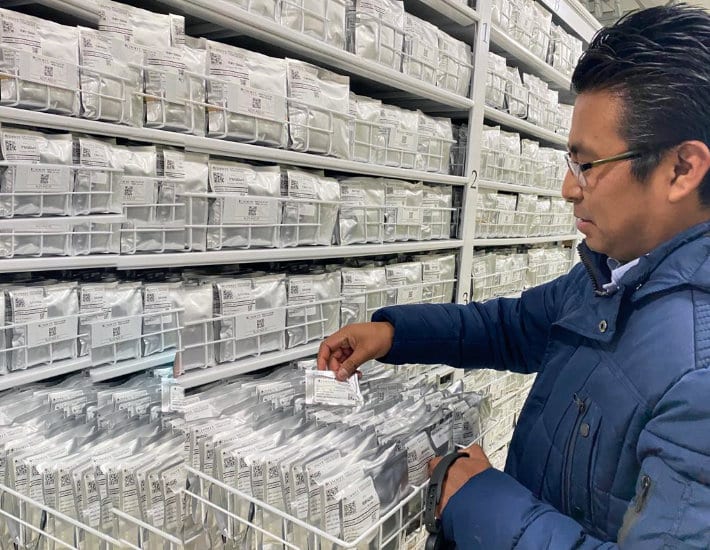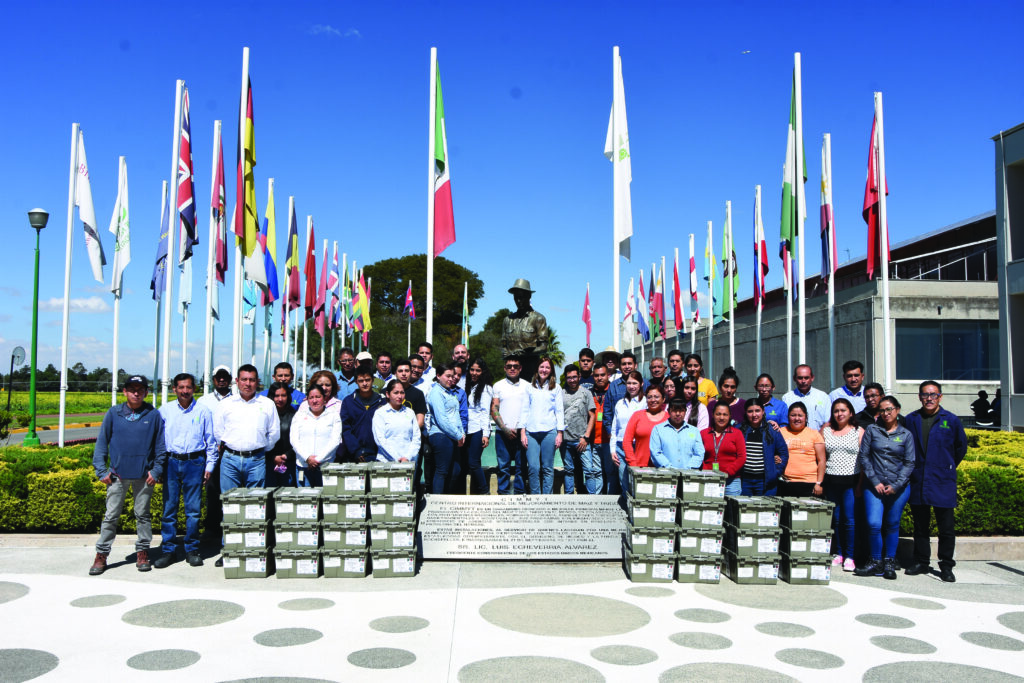The power of one germplasm
bank: combined and
streamlined
In 2022, CIMMYT combined its maize and wheat germplasm banks into one. The maize and wheat collections each have their own curators, but most other staff work on both crops, for added efficiency. Modern protocols, like vacuum-sealed seed packets with QR codes, allow seed orders to be filled faster than before.
In 2022, CIMMYT’s Wheat and Maize germplasm bank operations were unified to achieve greater efficiency, speed and quality of every process. Previously each crop had its own separate staff. Now, there is still one curator for maize and another for wheat, but most other team members work on both crops.
“CIMMYT had one of the world’s biggest wheat and maize collections. Now, with new technologies in fields like molecular characterization and data management, we are facing a new era for germplasm banks, and we are transforming the living archive collections into a bio-digital resource center,” says Carolina Sansaloni, wheat curator for the germplasm bank, and genotyping and sequencing specialist.
The germplasm bank has 126,000 accessions of wheat and 28,000 of maize, gathered from over 150 countries. The material is shared with farmers and plant breeders and other researchers from national agricultural research systems (NARS), universities, and advanced research institutes across the world. In 2022, CIMMYT distributed 3,180 wheat accessions, including 171 within Mexico. In maize, 4,652 accessions were shared, including 1,469 in Mexico.
The germplasm bank is now cleaning its inventory, removing redundant materials, and putting seed back into the collection in smaller, vacuum-sealed packages. New labels with QR codes make the packages easier to track.
“We introduced the concept of the ‘kangaroo package.’ Accessions in the active collection are organized with five packages ready for distribution, one for seed health tests and another for viability analysis,” explains Carolina Sansaloni. “With this approach we can greatly reduce the time needed to distribute the materials while we increase the longevity of the seeds.”
In 2022, the wheat collection reached its target of making more than ninety percent of the collection viable, healthy and available for distribution; it is expected that during 2023 the maize collection will also exceed 90% for these criteria. During the year, CIMMYT carried out 10,000 germination tests on its stored seed, to ensure that it was viable. Twenty thousand tests will be done in 2023.
As a safeguard, CIMMYT’s wheat collection is backed-up at other locations: 98% of the accessions are also held at the Svalbard Global Seed Vault in Norway, and 94% at the United States Department of Agriculture (USDA) Agricultural Genetic Resources Preservation Research in Fort Collins, Colorado. While 77% of the maize collection is also held in safety duplicate at these two locations, it is expected to reach 90% during 2023.
Seventy percent of CIMMYT’s wheat accessions have been genetically characterized using next-generation sequencing technologies. With this information, CIMMYT developed a global wheat diversity analysis to understand and unlock the biodiversity conserved in the germplasm bank, allowing the targeted exploration of genes in the near future. Currently the germplasm bank is starting to use this genetic “fingerprint” (sequence) data together with climate, soil and other variables from the collection site for each accession to identify novel genetic diversity that breeders need to develop the varieties that are in demand.
CIMMYT and the Alliance of Bioversity International and CIAT created a community of practice of Latin American national germplasm banks. This is building and improving regional collaboration among 33 institutions in 14 countries. These partners have prioritized training to enhance their individual and collective effectiveness. CIMMYT hosted three training events during 2022, two virtual workshops and an in-person course in November. Twenty-four people from 13 countries met for five days to share information and to get to know each other. CIMMYT’s streamlined germplasm bank is sharing cutting-edge knowledge of wheat and maize conservation and genetic resources with the region’s experts.

Carolina Sansaloni
Wheat curator for the germplasm bank, and genotyping and sequencing specialist
CIMMYT had one of the world’s biggest wheat and maize collections. Now, with new technologies in fields like molecular characterization and data management, we are facing a new era for germplasm banks, and we are transforming the living archive collections into a bio-digital resource center.
During 2022, opportunities were found to increase the number of maize accessions that CIMMYT can regenerate each year. “We now have permission from Mexico’s National Service for Food and Agricultural Health, Safety and Quality (SENASICA), to regenerate maize accessions both on CIMMYT’s experimental stations and at other locations, so we can better select suitable environments to multiply accessions that originate from many countries and diverse ecologies. In each regeneration cycle the new seed will be compared with the original, using molecular markers, to ensure that the original collection has been faithfully reproduced”, says Alberto Chassaigne, seed systems specialist and maize curator for CIMMYT’s germplasm bank.

Alberto Chassaigne
Maize curator for the germplasm bank, and seed systems specialist
We now have permission from Mexico’s National Service for Food and Agricultural Health, Safety and Quality (SENASICA), to regenerate maize accessions both on CIMMYT’s experimental stations and at other locations, so we can better select suitable environments to multiply accessions that originate from many countries and diverse ecologies. In each regeneration cycle the new seed will be compared with the original, using molecular markers, to ensure that the original collection has been faithfully reproduced.

Germplasm bank members work in a united bank for greater effectiveness. ©Carolina Sansaloni /CIMMYT.
The maize and wheat collections each have their own curators, but most other staff work on both crops, for added efficiency.
The maize and wheat collections each have their own curators, but most other staff work on both crops, for added efficiency.